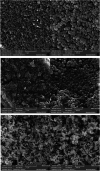Comparison of anti-biofilm and cytotoxic activity of Ag/AgO, Ag/Ag2O, and Ag/AgCl nanocomposites synthesized using stem, leaf, and fruit pericarp of Prunus mahaleb L
- PMID: 40691687
- PMCID: PMC12280217
- DOI: 10.1038/s41598-025-11756-7
Comparison of anti-biofilm and cytotoxic activity of Ag/AgO, Ag/Ag2O, and Ag/AgCl nanocomposites synthesized using stem, leaf, and fruit pericarp of Prunus mahaleb L
Abstract
The green synthesis of nanoparticles using plant-derived biomolecules provides an eco-friendly, cost-effective, and scalable approach with minimal environmental impact. The present study investigates the green synthesis of silver-based nanocomposites (AgNPs) using aqueous extracts from various anatomical parts of the stem, leaf, and fruit pericarp of Prunus mahaleb L., to assess their physicochemical properties, antibiofilm performance, and cytotoxic potential. Unlike conventional single-part plant synthesis, our multi-part approach introduces a diverse array of phytoconstituents, enhancing nanoparticle stability, morphological homogeneity, and functional bioactivity. UV-Vis spectroscopy revealed surface plasmon resonance (SPR) peaks at 426.00 nm, 414.00 nm, and 426.50 nm for Ag/AgO, Ag/Ag₂O, and Ag/AgCl nanocomposites, respectively, indicating successful nanoparticle formation. FT-IR confirmed the presence of functional groups involved in reduction and stabilization. XRD patterns validated the crystalline nature of the nanocomposites, with Ag/AgO displaying the smallest crystallite size. SEM analyses showed spherical morphologies with average sizes of 43.55 nm (stem), 45.44 nm (leaf), and 61.66 nm (fruit pericarp), consistent with EDX-determined silver contents of 9.01%, 42.34%, and 18.25%, respectively. In bioactivity assays, Ag/AgO and Ag/Ag₂O nanocomposites demonstrated moderate biofilm inhibition and exhibited pronounced cytotoxicity in brine shrimp lethality assay (LC₅₀ = 28 ± 0.42 µg/ml and 28 ± 0.40 µg/ml, respectively). In contrast, the Ag/AgCl nanocomposite synthesized from the fruit pericarp extract showed strong anti-biofilm activity, with inhibition percentages reaching up to 145.71%, though it exhibited lower cytotoxicity (LC₅₀ > 300 µg/ml). These results demonstrate the potential of P. mahaleb-mediated nanocomposites as promising candidates for biomedical applications, particularly in the development of novel antimicrobial and anticancer agents.
Keywords: Prunus mahaleb; Anti-biofilm; Cytotoxic activity; Green synthesis; Silver nanoparticles.
© 2025. The Author(s).
Conflict of interest statement
Declaration. Competing interests: The authors declare no competing interests. Ethics approval: All procedures are fully compliant with applicable institutional, national, and international regulations and standards.
Figures









Similar articles
-
Biosynthesis and characterization of silver nanoparticles from Asplenium dalhousiae and their potential biological properties.PLoS One. 2025 Jun 30;20(6):e0325533. doi: 10.1371/journal.pone.0325533. eCollection 2025. PLoS One. 2025. PMID: 40587502 Free PMC article.
-
Green-synthesized silver-copper nanocomposites from Sargassum latifolium: antibacterial, anticancer, and in silico pharmacokinetic evaluation.Med Oncol. 2025 Jul 16;42(8):339. doi: 10.1007/s12032-025-02899-8. Med Oncol. 2025. PMID: 40670822
-
Structural insights and biomedical potential of biosynthesized silver nanoparticles: antibacterial activity, anti-biofilm and cancer cell inhibition.PeerJ. 2025 Jul 1;13:e19608. doi: 10.7717/peerj.19608. eCollection 2025. PeerJ. 2025. PMID: 40620779 Free PMC article.
-
Green Synthesis of Titanium Dioxide Nanoparticles: Physicochemical Characterization and Applications: A Review.Int J Mol Sci. 2025 Jun 6;26(12):5454. doi: 10.3390/ijms26125454. Int J Mol Sci. 2025. PMID: 40564917 Free PMC article. Review.
-
An evidence-based environmental perspective of manufactured silver nanoparticle in syntheses and applications: a systematic review and critical appraisal of peer-reviewed scientific papers.Sci Total Environ. 2010 Feb 1;408(5):999-1006. doi: 10.1016/j.scitotenv.2009.11.003. Epub 2009 Nov 27. Sci Total Environ. 2010. PMID: 19945151
References
-
- Sintubin, L. et al. Lactic acid bacteria as reducing and capping agent for the fast and efficient production of silver nanoparticles. Appl. Microbiol. Biotechnol.84(4), 741–749 (2009). - PubMed
-
- Mukherjee, P. et al. Green synthesis of highly stabilized nanocrystalline silver particles by a non-pathogenic and agriculturally important fungus T asperellum. Nanotechnology19(7), 075103 (2008). - PubMed
-
- Ahmad, N.; Sharma, S. Green synthesis of silver nanoparticles using extracts of Ananas comosus. 2012.
-
- Lateef, A. et al. Cocoa pod husk extract-mediated biosynthesis of silver nanoparticles: its antimicrobial, antioxidant and larvicidal activities. J. Nanostruct. Chem.6(2), 159–169 (2016).
-
- alias Antonysamy, M. J., Santhanam, A., Thangaiah, S., Narayanan, J.,. Green synthesis of silver nanoparticles using Cyathea nilgirensis Holttum and their cytotoxic and phytotoxic potentials. Particulate Sci. Technol.36(5), 578–582 (2018).
Publication types
MeSH terms
Substances
LinkOut - more resources
Full Text Sources

